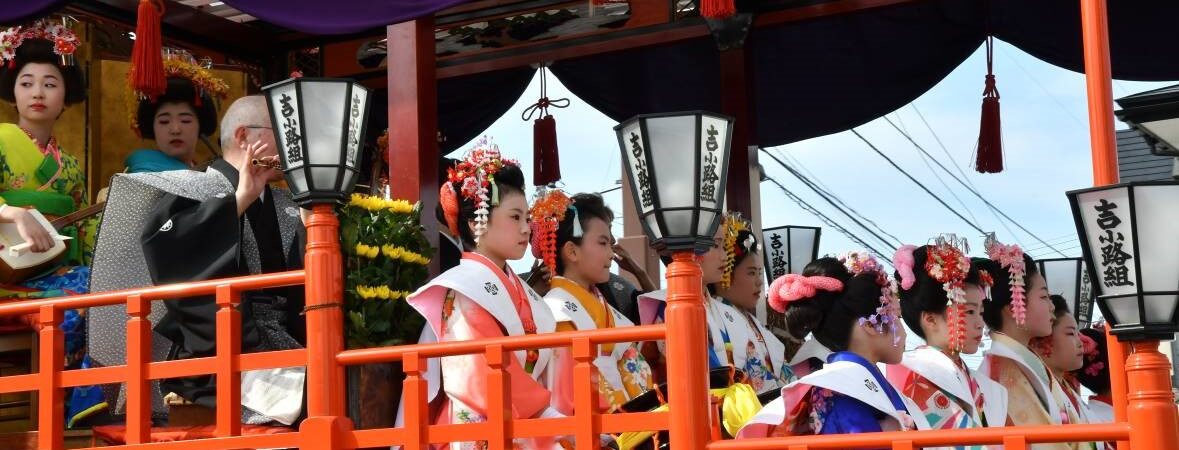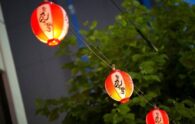On the last Saturday of April, the area around Mizusawa Station in Oshu becomes alive with floats, the traditional music of shamisen and taiko drums flows through the air, and crowds of people line the streets in anticipation. This is Hitaka-Hibuse Festival, one of Oshu’s most iconic events. For spectators, it’s a feast for the eyes and ears, and is a well-deserved Iwate Intangible Folk Cultural Property. As the 2024 edition just concluded, and since I was lucky enough to participate by pushing a float, I’d like to talk about the origins of this festival, what it’s like today, and how it felt to take part.
The Backstory
Hitaka-Hibuse Festival has a 300 year history – dating from a time when fires plagued Mizusawa (now a part of Oshu.) Mizusawa was a castle town, and when a lord of Mizusawa Castle witnessed the Great Fire of Meireki in Edo (present-day Tokyo) at a young age, it gave him a visceral understanding of how horrific fire disasters were. When he returned from Edo, fire brigades formed and firefighting strategies developed from this catalyst. Prayers to the gods for their help in preventing fires were made as well; thus, Hitaka-Hibuse Festival began.
Present Day
Nowadays of course, with the progress of modern technology, the threat of major fires isn’t as it was hundreds of years ago. Still, Hitaka-Hibuse Festival remains as a way to hope for protection against them. And by continuing to hold this traditional festival, the region is able to preserve it and pass it down to the next generation. The main attraction is the gorgeous parade of floats, of which there are three types.
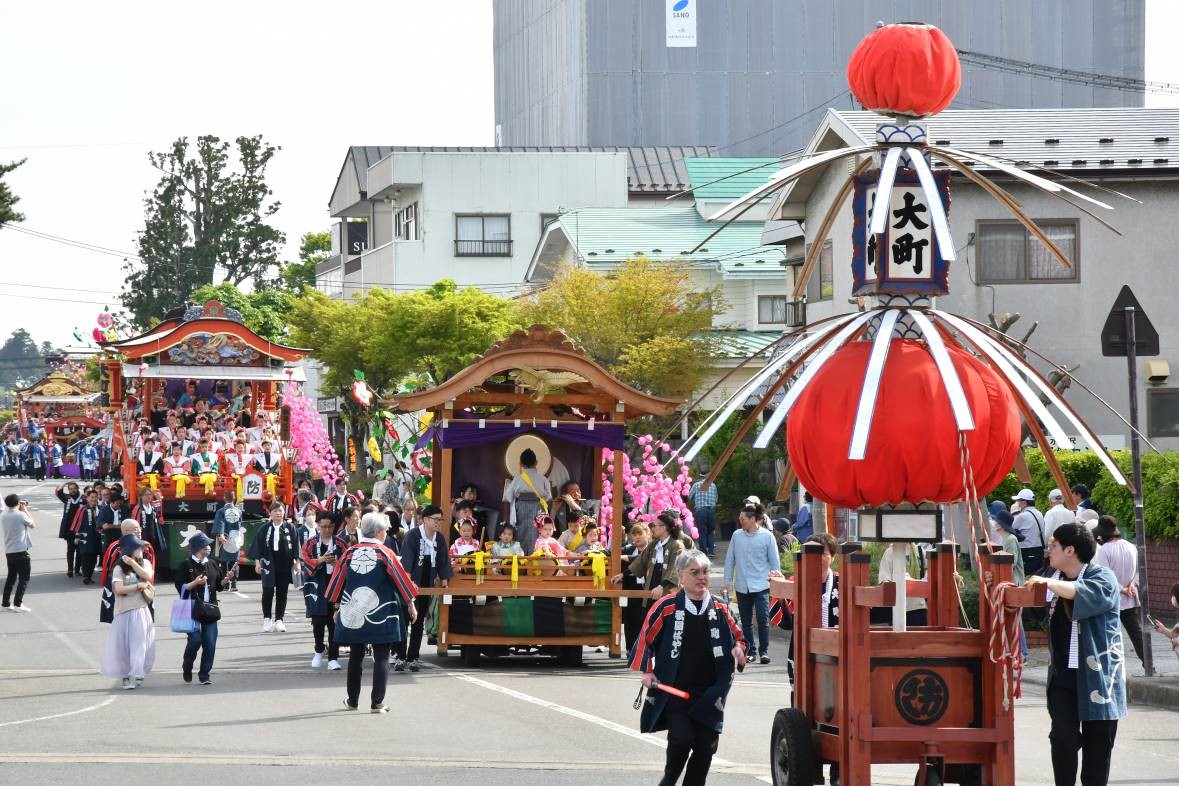
All three kinds of floats, moving down the street.
Chojirushi, seen on the rightmost side of the image above, are symbols of each of the former Mizusawa Castle town neighborhoods. Historically, each neighborhood had an associated kanji character, which is written on the chojirushi today; together, they spell out a message to the effect of “take care to prevent fires.” Their red spheres that symbolize fire, and paper streamers that symbolize water, are their defining characteristics.
Uchibayashi are simple floats that are close to the ground, and they also represent the six former castle town neighborhoods. These can carry a handful of young children playing taiko drums, plus two flautists.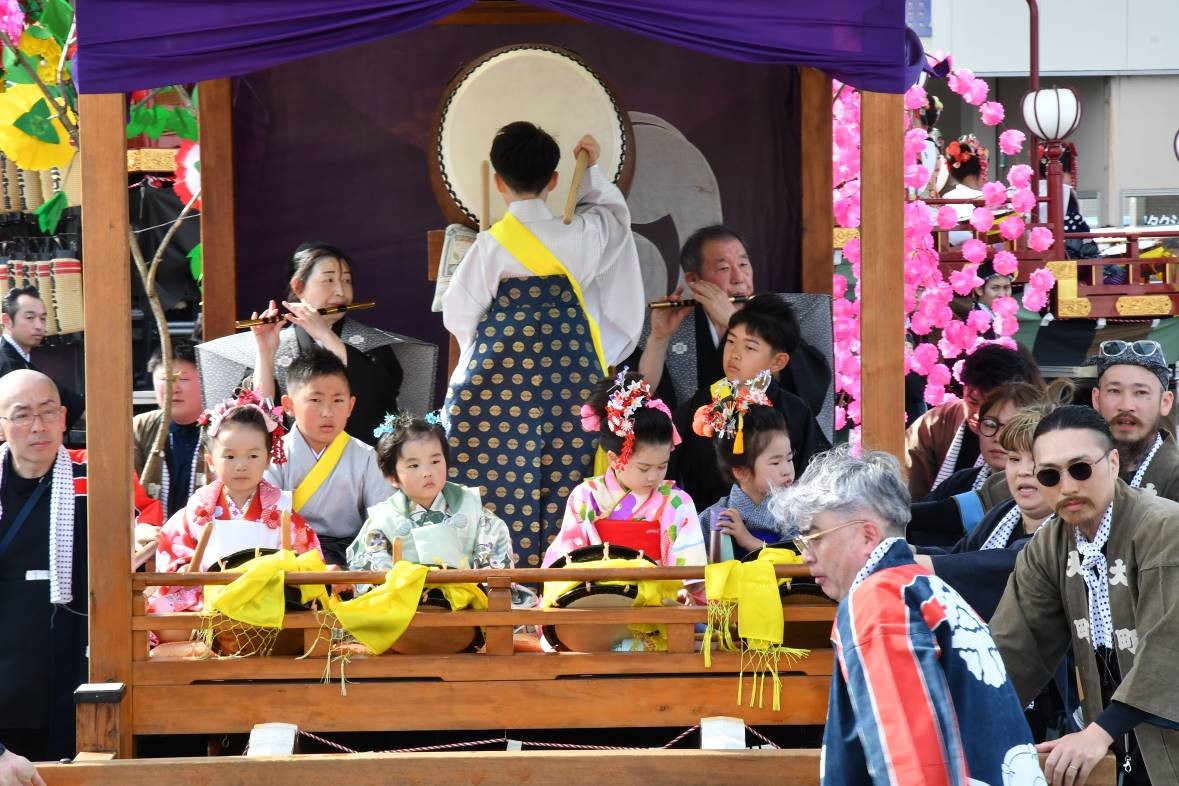
Uchibayashi in action during the festival.
But the next type – hayashi-yatai – are definitely the showstoppers.
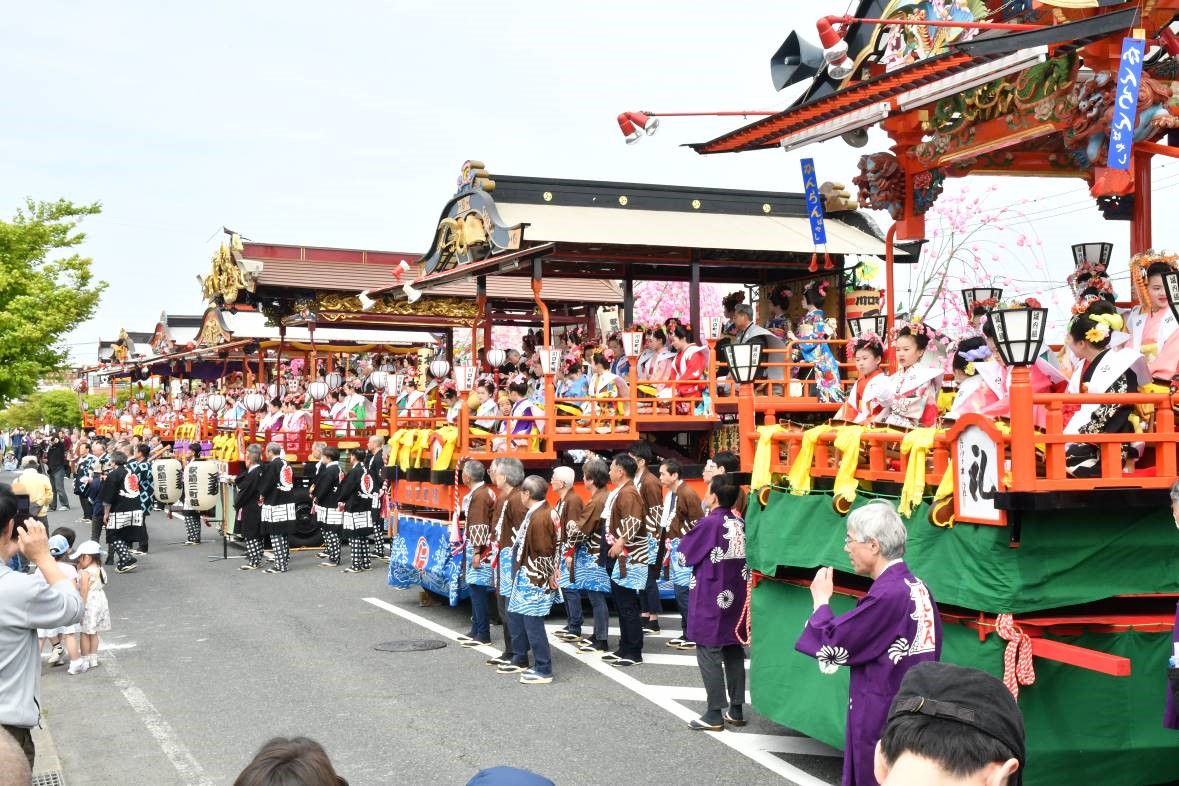
Hayashi-yatai, gathered in preparation for the festival.
Hayashi-yatai bear several older children playing kodaiko drums, six people strumming the shamisen, and two flautists. Shiplike and graceful, they move through the streets with grandeur; when dusk falls and lanterns illuminate them, the scene appears almost unreal, like a scene out of classical Japanese artwork.
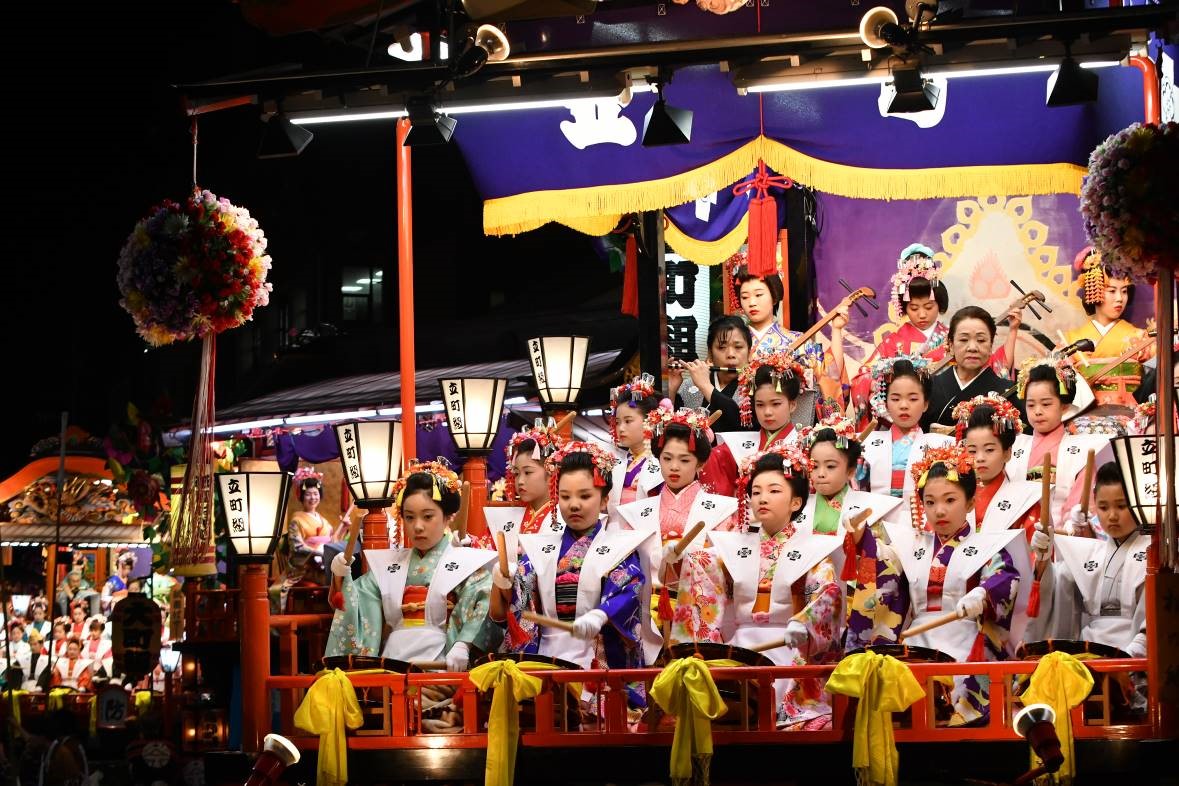
A hayashi-yatai float in the evening.
And the floats aren’t the only draw of the festival. Myriad local cultural performances, such as the dances of the 42 and 25 year-old yaku-doshi (unlucky year) groups, adorn the streets and add to the joy of the day.
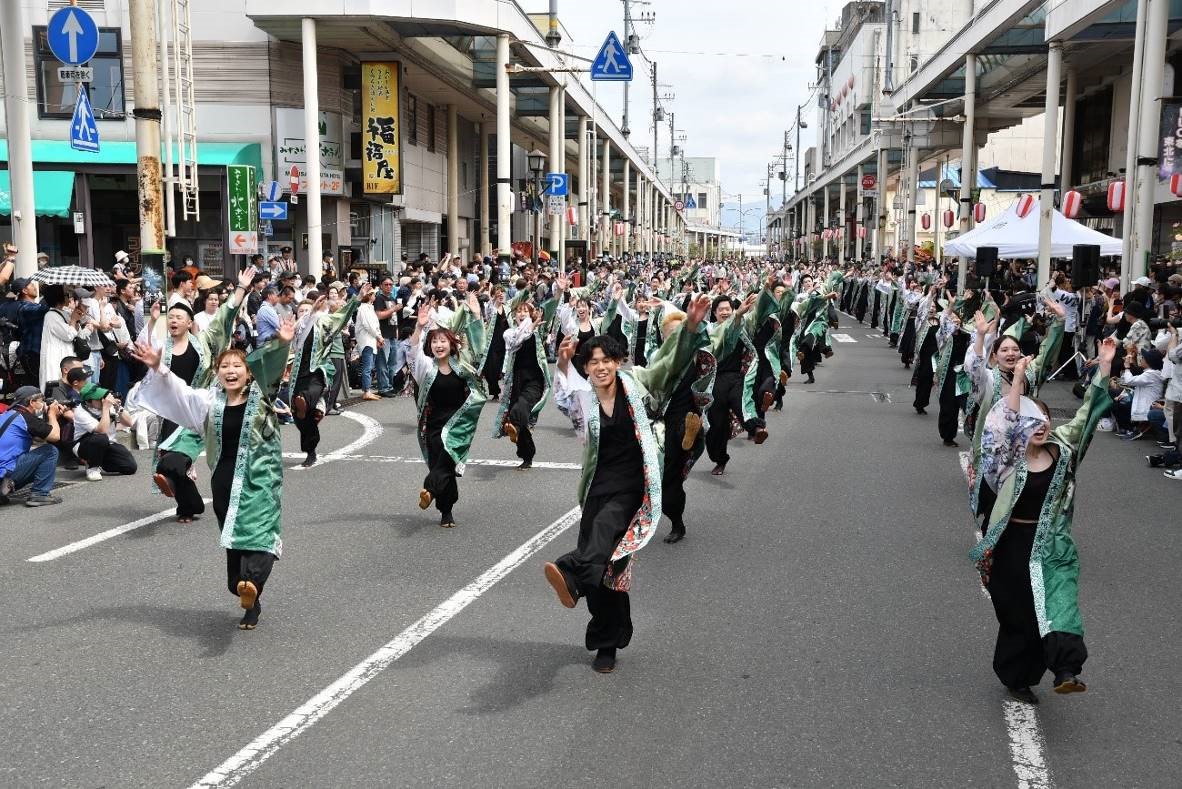
One of the yaku-doshi groups mid-dance.
What’s It Like to Push a Float?
Thanks to a lucky chance, I was able to participate in this festival. As someone who loves Oshu and wants to see its festivals flourish, I was thrilled to be able to contribute. Children on uchibayashi floats can be as young as 2, so all of us who were pushing these floats gave them lots of praise for drumming, and the cool older kids on the hayashi-yatai encouraged them with words and smiles too.
The beauty of festival participants’ hard work and cooperation, regardless of nationality, really impressed me. The floats may be majestic, but it’s the people that bring them to life. Also, I felt very welcomed and included by the local people, my own birthplace notwithstanding. If you come to Oshu or this region from elsewhere, and want to participate, I’m sure you would be welcome to do so. In the future, as more international residents of Oshu take part, I hope that a festival as beautiful as Hitaka-Hibuse will be able to persist for many years to come.
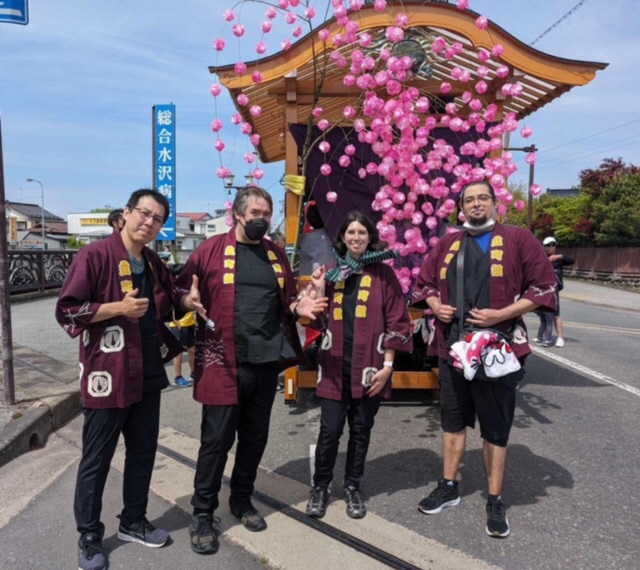 The four of us foreigners, with our chojirushi
The four of us foreigners, with our chojirushi
Japanese
日高火防祭 豪華絢爛な一大絵巻のようにはじめに
4月の最終土曜日、奥州市の水沢駅周辺は屋台で賑わい、三味線や太鼓の伝統的な音楽は風に乗り、誘われるように期待に胸を躍らせた人たちが大勢集まります。
「日高火防祭」は、奥州市を象徴する祭りのひとつです。見に来た人たちにとっては、目でも耳でも大いに楽しめるこの祭りは素晴らしいものであり、岩手県無形民俗文化財に登録されたことも頷けます。2024年の祭りが終わり、私は幸運なことに屋台を引くことで祭りに参加できたので、「日高火防祭」の由来、現状、そしてこれからについて少しだけ話したいと思います。
歴史・由来について
日高火防祭は300年の歴史がある祭りです。昔、水沢(現:奥州市の一部)は火災に悩まされていた時代がありました。
水沢は城下町で、少年時代の水沢城主は、江戸(現:東京)で起こった明暦3年の大火を目撃し、火災の惨禍を痛感しました。これをきっかけに、水沢城主は江戸から帰還した際、消防隊を創設するなど、火伏の対策に力をいれるようになったのです。
また、神の力を借りて火災を未然に防ごうと祈願し、始められたのがこの「日高火防祭」です。
現在について
近年は、技術が進み何百年前のように大火を恐れる必要もなくなりました。しかし、火災が無くなるよう祈願し、現在でも祭りは続いています。また、地域では、この伝統の祭りを披露し続けることにより、後世にも残し伝えようとしています。
日高火防祭の見どころは3種類の豪華な屋台が練り歩くことです。
上の写真の1番右にあるのは「町印」といいます。これはそれぞれの町のシンボルです。当時、旧水沢城下町では火災を防ぐ心構えを意味する「仁心をもって火防定鎮す」の漢字が1文字ずつ与えられ、「町印」にそれが書かれています。また、町印は火を象徴する赤玉と水を象徴する馬簾が特徴です。
打ちばやしは素朴で低い屋台、6町の屋台があります。太鼓を打つ子どもと笛師2人を乗せます。
次の「はやし屋台」はまた異なる趣があります。
「はやし屋台」は、小太鼓を打つ子供たち、三味線を弾く6人、笛を吹く2人を乗せ、優雅で船のように堂々と町を練り歩きます。夜になるとぼんぼりが灯り、この世のものとは思えないほど華やかな屋台はまるで古典美術品のようです。
しかも、祭りの魅力は屋台だけではありません。42歳と25歳の厄年連の踊りなど、様々な地域の文化的な演奏や演舞が町を非日常の世界に彩ります。
祭りに参加して感じたこと
今回、機会に恵まれ、祭りに参加することができました。奥州市が大好きな市民の1人として、祭りを盛り上げることに貢献できたことは大変嬉しかったです。打ちばやしの子どもたちの中には2歳の幼い子供もいて、屋台を引く誰もがその子が上手に太鼓を打つことを褒めて、はやし屋台の素敵なお姉さん・お兄さんたちも笑顔と言葉で励ましました。
国籍関係なく、祭りに参加した人々の努力、協力の姿は美しく、本当に印象に残りました。屋台がどんなに華やかでも、人の力がなければ意味がありません。また、私がどこで生まれたかなど関係なく、地域の人に歓迎され、日本人と同じように受け入れられたと感じました。もしあなたが別の場所から奥州市や地域にやってきて、「祭りに参加したい」と思うなら、受け入れてくれるに違いありません。
今後、もっと多くの奥州市の外国人も参加し、「日高火防祭」という美しい祭りがずっと続くことを願います。
